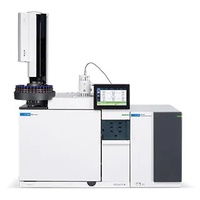Atomic Emission Detector (AED)
The JAS AED is the only commercially available atomic emission detector (AED) for gas chromatographie. It lets you detect virtually all elements within any volatized compound (except helium, the carrier gas) at picogram-level sensitivities, with excellent selectivities. The JAS AED transports sophisticated research capabilities into a reliable, cost effective instrument that is easy to use and maintain - ideal both routine QA/QC and research laboratories.
The JAS AED uses atomic emission spectroscopy to detect elements in compounds eluting from a gas chromatograph. A helium plasma fragments all compounds, with the excited atoms producing characteristic emission lines of light. A lens focuses the light onto the entrance slit of the spectrometer. A rotating grating varies the elemental light spectrum covered by the fixed-position photodiode array (PDA). The PDA can measure from one to several elements simultaneously. The JAS AED can detect any number of elements per sample by automatically changing the light spectrum wavelength range focused on the PDA and subsequently making a second (or third or more) injection of the sample.
Áreas De aplicación el AED
Es un instrumento versátil que se puede utilizar para un gran número de aplicaciones en diferentes industrias como:
- Industria petroquímica (p.ej. el azufre en el combustible, SimDis)
- Análisis ambiental (p.ej. organométalicos en pesticidas)
- Militar (p.ej. agentes de guerra químicos)
- Gases de alta pureza alta (análisis de trazas)
- Industria de semiconductores
- Industria de automoción
Principales ventajas:
- Análisis y detección de más de 26 elementos
- Respuesta equimolar
- Bajos límites de detección
- Permite cualificación y cuantificación
- Compatible para análisis rutinario y de investigación
- Temperatura de uso de hasta 450°C
- Detección de multi elementos en un solo GC
- Análisis de multi elemento SimDis
- Screnning de elementos antes de su análisis por MS
- Búsqueda rápida de compuestos
- Calibración independiente del compuesto
| Interfase | Interfase termostatizada a 450ºC |
| Generador Microondas | |
| Frecuencia | 2,450Hz |
| Nivel de Potencia |
70 watts |
| Tubo de potencia | 2M211 Magnetron |
| Tunning | No requiere |
| Emisión perdida | < 5 Mw/Cm2 A 5cm |
| Plasma de microondas | |
| Cavidad | diseño de retirada |
| Tubo de descarga | Refrigerado con agua, 0,1mm de grosor |
| Ignición |
Automática |
| Salida | Del tubo de descarga a la cámara de purga |
| Espectrofotómetro | |
| Tipo | 0,25-m Czerney-Turner |
| Longitudes de onda |
171 a 837nm |
| Condiciones ambientales | |
| Condiciones extremas funcionamiento | 10 a 40ºC |
| Humedad |
80% para temperaturas superiores a 31ºC, decrece la linealidad para humedad del 50% a temperaturas de 40ºC |
| Condiciones almacenamientos | (-40ºC a 65ºC) |
| Dimensiones y Peso | |
| Dimensiones | 52cm x 57cm x 41cm |
| Peso | 37Kg |
Lista de Compuestos que se pueden analizar con el AED, con sus correspondiente longitud de onda y gases reactantes.
| Grupo | Elementos | Longitud de onda (nm) | Gas de reacción | Grupo | Elementos | Longitud de onda (nm) | Gas de reacción |
| 1 | Carbon | 193 | Oxígeno y Helio |
11 | Lead | 261 | Oxígeno y Hidrógeno (Helio a flujo alto) |
| Iodine | 183 | " " | Manganese | 259 | " " | ||
| Sulfur | 181 | " " | Mercury | 254 | " " | ||
| Carbon |
179 | " " | Silicon | 252 | " " | ||
| Nitrogen | 174 | " " | Carbon | 248 | " " | ||
| 2 | Carbon | 496 | Oxígeno | 12 | Tin | 271 | Oxígeno y Hidrógeno (Helio a flujo alto) |
| Hydrogen | 486 | " " | Germanium | 265 | " " | ||
| Chlorine | 479 | " " | Carbon | 264 | " " | ||
| Bromine | 478 | " " | Lead | 261 | " " | ||
| 3 | Phosphorus | 178 | Hidrógeno (Helio a flujo alto) | Manganese | 259 | " " | |
| 4 | Oxygen | 171 | Hidrógeno y 10% CH4 / 90% N2 |
Mercury | 254 | " " | |
| 5 | Nitrogen | 388 | Oxígeno, Hidrógeno y Metano (Helio a flujo alto) | Silicon | 252 | " " | |
| 6 | Fluorine | 609 | Hidrógeno | 13 | Tin | 303 | Oxígeno y Hidrógeno (Helio a flujo alto) |
| 7 | Iodine | 206 | Oxígeno y Hidrógeno | Iron | 302 | " " | |
| 8 | Chlorine | 837 | Oxíg | ||||

